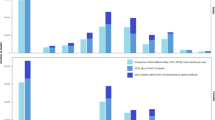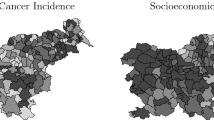Abstract
A meaningful characterization of epidemiologic fields (mortality, incidence rate, etc.) often involves the assessment of their spatiotemporal variation at multiple scales. An adequate analysis should depend on the scale at which the epidemiologic field is considered rather than being limited by the scale at which the data are available. In many studies, for example, data are available at a larger scale (say, counties), whereas the epidemiologist is interested in a smaller-scale analysis (say, residential neighborhoods). We propose a mathematically rigorous and epidemiologically meaningful multiscale approach that uses the well-known BME theory to study important scale effects and generate informative scale-dependent maps. The approach is applied to a real-world case study involving daily mortality counts in the state of California. The approach accounts for scale effects and produces mortality predictions at the zip-code scale by downscaling data from the county scale. The multiscale approach is tested by means of a verification data set with detailed mortality information at the zip-code level for 1 day. A measure of mapping accuracy is used to demonstrate that the multiscale approach offers more accurate mortality predictions at the local scale than existing approaches, which do not account for scale effects.
This is a preview of subscription content, access via your institution
Access options
Subscribe to this journal
Receive 6 print issues and online access
$259.00 per year
only $43.17 per issue
Buy this article
- Purchase on Springer Link
- Instant access to full article PDF
Prices may be subject to local taxes which are calculated during checkout









Similar content being viewed by others
References
Carrat F., and, Valleron A.-J. Epidemiologic mapping using the ‘kriging’ method: Application to an influenza-like illness epidemic in France. Am J Epidemiol 1992: 135 (11): 1293–1300.
Choi K.M. BME-based spatiotemporal local scale mapping and filtering with mortality data: The California Study. Ph.D. Thesis, Department of Environment Science & Engineering, University of North Carolina at Chapel Hill, NC, 2001.
Choi K.-M., Christakos G., and, Serre M.L. Space/time BME analysis of the mortality rate in California as a health indicator at spatially local scale using the BME method. Superfund Basic Research Program Annual Conference, Chapel Hill, NC, 2000.
Christakos G. Random Field Models in Earth Sciences. Academic Press, San Diego, CA, 1992.
Christakos G. Spatiotemporal information systems in soil and environmental sciences. Geoderma, 1998: 85 (2–3): 141–179.
Christakos G. Modern Spatiotemporal Geostatistics. Oxford University Press, New York, NY, 2000 (3rd print, 2001).
Christakos G, Bogaert P., and, Serre M.L. Temporal GIS. Springer Verlag, New York, NY, 2001 (CD ROM included).
Christakos G., and, Hristopulos D.T. Spatiotemporal Environmental Health Modelling: A Tractatus Stochasticus. Kluwer Academic Publisher, Boston, MA, 1998.
Christakos G., and, Kolovos A. A study of the spatiotemporal health impacts of ozone exposure. J Exposure Anal Environ Epidemiol, 1999: 9 (4): 322–335.
Christakos G., and, Lai J. A study of the breast cancer dynamics in North Carolina. Social Science & Medicine, 1997: 45 (10): 1503–1517.
Christakos G., and, Serre M.L. A spatiotemporal study of exposure–health effect associations. J Exposure Anal Environ Epidemiol, 2000: 10 (2): 168–187.
DSMF (Death Statistical Master Files). Center for Health Statistics, Sacramento, CA, 1989.
Kirby R.S. Toward congruence between theory and practice in small area analysis and local public health data. Statist Med, 1996: 15: 1859–1866.
Mayer J.D. The role of spatial analysis and geographic data in the detection of disease causation. Soc Sci Med, 1983: 17 (16): 1213–1221.
Morris R.D., and, Munasinghe R. Aggregation of existing geographic regions to diminish spurious variability of disease rates. Statist Med, 1993: 12: 1915–1929.
Muir C.S. International variation in high-risk populations. In: Fraumeni J.F. Jr. (Ed.). Persons at High Risk of Cancer. An Approach to Cancer Etiology and Control. Academic Press, New York, NY, 1975, pp. 293–305.
Oliver M.A., Muir K.R., Webster R., Parkes S.E., Cameron A.H., Stevens M.C.G., and, Mann J.R. A geostatistical approach to the analysis of pattern in rare disease. J Public Health Med, 1992: 14 (3): 280–289.
Pukkala E. Cancer maps in Finland: An example of small area-based mapping. Recent Results Cancer Res, 1989: 114: 208–215.
Serre, M.L., and, Christakos G. BME studies of stochastic differential equations representing physical laws — Part II. In IAMG99, Proceedings of 5th Annual Conference of the International Association for Mathematical Geology, 6–11 August 1999, Trondheim, Norway, 1999.
Waller L.A. A civil action and statistical assessments of the spatial pattern of disease: do we have a cluster?. Regul Toxicol Pharmacol., 2000: 32: 174–183.
Waller L.A., and, Turnbull B.W. The effects of scale on tests for disease clustering. Statist Med, 1993: 12: 1869–1884.
Walter S.D., and, Birnie S.E. Mapping mortality and morbidity patterns: An international comparison. Int J Epidemiol, 1991: 20: 678–689.
Wartenberg D., and, Greenberg M. Detecting disease clusters: the importance of statistical power. Am J Epidemiol, 1990: 132: S156–S166.
Acknowledgements
This work was supported by grants from the National Institute of Environmental Health Sciences (Grant No. P42-ES05948 and P30-ES10126), the National Aeronautics and Space Administration/Science Application International Group (Grant No. 60-00RFQ041), and the US Civilian Research & Development Foundation (Grant No. RJ2-2236).
Author information
Authors and Affiliations
Corresponding author
Rights and permissions
About this article
Cite this article
Choi, KM., Serre, M. & Christakos, G. Efficient mapping of California mortality fields at different spatial scales. J Expo Sci Environ Epidemiol 13, 120–133 (2003). https://doi.org/10.1038/sj.jea.7500263
Received:
Published:
Issue Date:
DOI: https://doi.org/10.1038/sj.jea.7500263
Keywords
This article is cited by
-
A Bayesian maximum entropy model for predicting tsetse ecological distributions
International Journal of Health Geographics (2023)
-
A spatial functional count model for heterogeneity analysis in time
Stochastic Environmental Research and Risk Assessment (2021)
-
BME prediction of continuous geographical properties using auxiliary variables
Stochastic Environmental Research and Risk Assessment (2016)
-
Model-driven development of covariances for spatiotemporal environmental health assessment
Environmental Monitoring and Assessment (2013)
-
Adjusting for sampling variability in sparse data: geostatistical approaches to disease mapping
International Journal of Health Geographics (2011)



